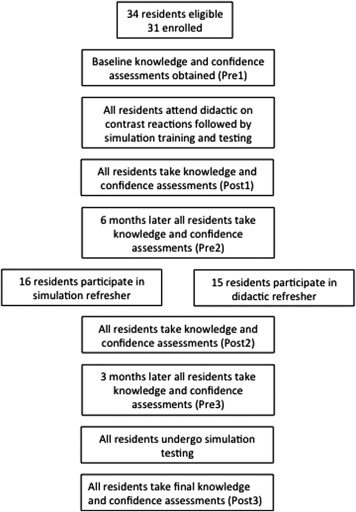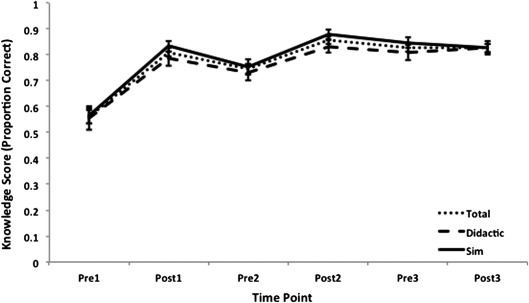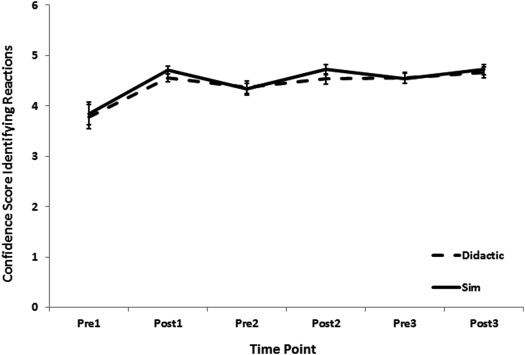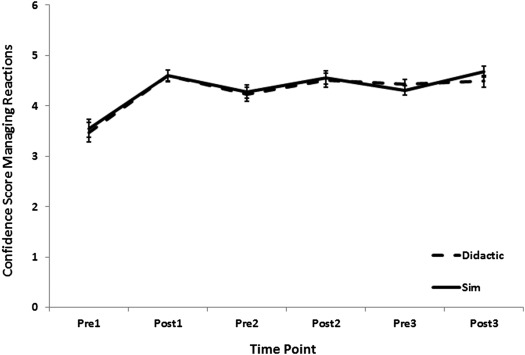Rationale and Objectives
Simulation-based training has been shown to be a useful adjunct to standard didactic lecture in teaching residents appropriate management of adverse contrast reactions. In addition, it has been suggested that a biannual refresher is needed; however, the type of refresher education has not been assessed.
Materials and Methods
This was a prospective study involving 31 radiology residents across all years in a university program. All residents underwent standard didactic lecture followed by high-fidelity simulation-based training. At approximately 6 months, residents were randomized into a didactic versus simulation group for a refresher. At approximately 9 months, all residents returned to the simulation center for performance testing. Knowledge and confidence assessments were obtained from all participants before and after each phase. Performance testing was obtained at each simulation session and scored based on predefined critical actions.
Results
There was significant improvement in knowledge ( P < .002) and confidence ( P < .001) after baseline education of combined didactic and simulation-based training. There was no statistical difference between the simulation and didactic groups in knowledge or confidence at any phase of the study. There was no significant difference in tested performance between the groups in either performance testing session.
Conclusions
This study suggests that a curriculum consisting of an annual didactic lecture combined with simulation-based training followed by a didactic refresher at 6 months is an effective and efficient (both cost-effective and time-effective) method of educating radiology residents in the management of adverse contrast reactions.
Acute adverse reactions to contrast administration are rare events, estimated at an incidence of 0.2%–3.1% . These can range from mild and self-limiting to life-threatening reactions. Recent surveys of radiologists have shown that there is a deficiency in knowledge of epinephrine for the management of adverse contrast reactions with only 41–43% of radiologists providing the correct dose, route, and concentration of the drug . These findings have raised concern that standard didactic-based instruction may not be sufficient training in the management of adverse contrast reactions. The addition of simulation-based training has been shown to improve resident management of contrast reactions . More recent studies have determined that although there is improvement in knowledge and confidence in the management of adverse contrast reactions when a combined didactic and scenario-based curriculum is used, the effect of this training begins to decline after 6 months. This study suggests that biannual refresher training should be considered . What has not been studied to date is the type of training that should be provided at the 6-month refresher mark, didactic or simulation, and what effect the type of reinforcement has on resident performance in the management of adverse contrast reactions. The objective of this prospective randomized study was to determine if there is a difference in knowledge, confidence, and tested performance for managing adverse contrast reactions based on simulation versus didactic refresher courses.
Materials and methods
This prospective study involved all radiology residents of postgraduate years 2–5 at a university program. Participation was voluntary, and written informed consent was obtained from each resident after the nature of the study was explained. Residents were assigned numbers to maintain their anonymity. This study was approved by the institutional review board of the hospital.
Get Radiology Tree app to read full this article<
Get Radiology Tree app to read full this article<
Get Radiology Tree app to read full this article<
Get Radiology Tree app to read full this article<
Phase 1
Get Radiology Tree app to read full this article<
Phase 2
Get Radiology Tree app to read full this article<
Phase 3
Get Radiology Tree app to read full this article<
Statistical analysis
Get Radiology Tree app to read full this article<
Get Radiology Tree app to read full this article<
Results
Get Radiology Tree app to read full this article<
Knowledge
Get Radiology Tree app to read full this article<
Table 1
Comparison of Scores Between Groups and Time Points
Group Pre1 Post1 Pre2 Post2 Pre3 Post3 Knowledge mean score % (SD) Overall 56 ± 15 81 ± 10 74 ± 12 86 ± 9 83 ± 10 83 ± 9 Didactic 56 ± 17 79 ± 11 73 ± 13 83 ± 9 81 ± 11 83 ± 10 Simulation 57 ± 12 83 ± 8 76 ± 11 88 ± 7 85 ± 8 83 ± 7P ∗ .847 .18 .602 .12 .303 .974 Confidence in identifying contrast reactions mean score (SD) Overall 3.8 ± 0.9 4.6 ± 0.3 4.4 ± 0.4 4.6 ± 0.4 4.6 ± 0.4 4.7 ± 0.4 Didactic 3.8 ± 0.9 4.6 ± 0.3 4.4 ± 0.5 4.6 ± 0.4 4.6 ± 0.4 4.7 ± 0.4 Simulation 3.8 ± 0.9 4.7 ± 0.3 4.3 ± 0.4 4.7 ± 0.4 4.5 ± 0.3 4.7 ± 0.4 Confidence in managing contrast reactions mean score (SD) Overall 3.5 ± 0.7 4.6 ± 0.4 4.3 ± 0.5 4.5 ± 0.5 4.4 ± 0.4 4.6 ± 0.5 Didactic 3.5 ± 0.7 4.6 ± 0.5 4.2 ± 0.7 4.6 ± 0.6 4.4 ± 0.3 4.5 ± 0.4 Simulation 3.6 ± 0.8 4.7 ± 0.3 4.3 ± 0.3 4.7 ± 0.4 4.3 ± 0.4 4.7 ± 0.5
Group Performance; Mean Score % (SD)P † Baseline Final Overall 98 ± 6 94 ± 9 .064 Didactic 97 ± 7 92 ± 11 .069 Simulation 98 ± 5 96 ± 7 .419P ∗ .564 .19
SD, standard deviation.
Get Radiology Tree app to read full this article<
Get Radiology Tree app to read full this article<
Table 2
Comparison of Knowledge Scores Between Time Points
Group Mean Score % (SD) Post1 Pre2 Post2 Pre3 Post3 Didactic Pre1 56 ± 17 <0.001 ∗ <0.001 ∗ <0.001 ∗ <0.001 ∗ <0.001 ∗ Post1 79 ± 11 0.831 0.774 1 0.908 Pre2 73 ± 13 0.018 ∗ 0.476 0.058 Post2 83 ± 9 1 1 Pre3 81 ± 11 1 Post3 83 ± 10 Simulation Pre1 57 ± 12 <0.001 ∗ <0.001 ∗ <0.001 ∗ <0.001 ∗ <0.001 ∗ Post1 83 ± 8 0.241 0.726 1 1 Pre2 76 ± 11 0.001 ∗ 0.191 0.28 Post2 88 ± 7 0.984 0.486 Pre3 85 ± 8 1 Post3 83 ± 7
SD, standard deviation.
Get Radiology Tree app to read full this article<
Get Radiology Tree app to read full this article<
Get Radiology Tree app to read full this article<
Get Radiology Tree app to read full this article<
Confidence
Get Radiology Tree app to read full this article<
Table 3
Comparison of Confidence Scores Between Time Points in Identifying Contrast Reactions
Group Mean Score (SD) Post1 Pre2 Post2 Pre3 Post3 Didactic Pre1 3.8 ± 0.9 0.013 ∗ 0.038 ∗ 0.027 ∗ 0.009 ∗ 0.001 ∗ Post1 4.6 ± 0.3 0.502 1 1 0.954 Pre2 4.4 ± 0.5 0.728 0.474 0.056 Post2 4.6 ± 0.4 1 0.975 Pre3 4.6 ± 0.4 0.832 Post3 4.7 ± 0.4 Simulation Pre1 3.8 ± 0.9 0.002 ∗ 0.093 0.003 ∗ 0.014 ∗ <0.001 ∗ Post1 4.7 ± 0.3 0.002 ∗ 1 0.501 1 Pre2 4.3 ± 0.4 0.002 ∗ 0.249 0.002 ∗ Post2 4.7 ± 0.4 0.622 1 Pre3 4.5 ± 0.3 0.103 Post3 4.7 ± 0.4
SD, standard deviation.
Get Radiology Tree app to read full this article<
Table 4
Comparison of Confidence Scores Between Time Points in Managing Contrast Reactions
Group Mean Score (SD) Post1 Pre2 Post2 Pre3 Post3 Didactic Pre1 3.5 ± 0.7 <0.001 ∗ 0.001 ∗ <0.001 ∗ <0.001 ∗ <0.001 ∗ Post1 4.6 ± 0.5 0.040 ∗ 0.998 0.692 0.943 Pre2 4.2 ± 0.7 0.312 0.891 0.518 Post2 4.6 ± 0.6 1 1 Pre3 4.4 ± 0.3 1 Post3 4.5 ± 0.4 Simulation Pre1 3.6 ± 0.8 <0.001 ∗ <0.001 ∗ <0.001 ∗ 0.001 ∗ <0.001 ∗ Post1 4.7 ± 0.3 0.067 1 0.026 ∗ 0.997 Pre2 4.3 ± 0.3 0.245 1 0.034 ∗ Post2 4.7 ± 0.4 0.194 0.908 Pre3 4.3 ± 0.4 <0.001 ∗ Post3 4.7 ± 0.5
SD, standard deviation.
Get Radiology Tree app to read full this article<
Get Radiology Tree app to read full this article<
Get Radiology Tree app to read full this article<
Performance
Get Radiology Tree app to read full this article<
Get Radiology Tree app to read full this article<
Discussion
Get Radiology Tree app to read full this article<
Get Radiology Tree app to read full this article<
Get Radiology Tree app to read full this article<
Get Radiology Tree app to read full this article<
Get Radiology Tree app to read full this article<
Limitations
Get Radiology Tree app to read full this article<
Conclusions
Get Radiology Tree app to read full this article<
Acknowledgments
Get Radiology Tree app to read full this article<
References
1. Cochran S.T., Bomyea K., Sayre J.W.: Trends in adverse events after IV administration of contrast media. Am J Roentgenol 2001; 176: pp. 1385-1388.
2. Katayama H., Yamaguchi K., Kozuka T., et. al.: Adverse reactions to ionic and nonionic contrast media: a report from the Japanese committee on the safety of contrast media. Radiology 1990; 175: pp. 621-628.
3. Wang C.W., Cohan R.H., Ellis J.H., et. al.: Frequency, outcome, and appropriateness of treatment of nonionic iodinated contrast media reactions. Am J Roentgenol 2008; 191: pp. 409-415.
4. Lightfoot C.B., Abraham R.J., Mammen T., et. al.: Survey of radiologists’ knowledge regarding the management of severe contrast-material induced allergic reactions. Radiology 2009; 251: pp. 691-696.
5. Bartlett M.L., Bynevelt M.: Acute contrast reaction management by radiologists: a local audit study. Australas Radiol 2003; 47: pp. 363-367.
6. Tubbs R.J., Murphy B., Mainiero M.B., et. al.: High fidelity medical simulation as an assessment tool for radiology residents’ acute contrast reaction management skills. J Am Coll Radiol 2009; 6: pp. 582-587.
7. Wang C.L., Schopp J.G., Petscavage J.M., et. al.: Prospective randomized comparison of standard didactic lecture versus high-fidelity simulation for radiology resident contrast reaction management training. AJR Am J Roentgenol 2011; 196: pp. 1288-1295.
8. Tofil N.M., White M.L., Grant M., et. al.: Severe contrast reaction emergencies: high-fidelity simulation training for radiology residents and technologists in a children’s hospital. Acad Radiol 2010; 17: pp. 934-940.
9. Trout A.T., Cohan R.H., Ellis J.H., et. al.: Teaching management of contrast reactions: does it work and how often do we need to refresh?. Acad Radiol 2012; 19: pp. 498-504.
10. Echenique A.M., Joseph R., Casillas V.J.: Recognition and treatment of reactions to contrast media: a model for resident and faculty education employing lectures and case scenario workshops. Acad Radiol 1997; 4: pp. 230-234.
11. Halstead M.J., Perry L., Racadio J.M.: Changing radiology resident education to meet today’s and tomorrow’s needs. J Am Coll Radiol 2004; 1: pp. 671-678.
12. Issenberg S.B.: The scope of simulation-based healthcare education. Simul Healthcare 2006; 1: pp. 203-208.
13. Petscavage J.M., Paladin A.M., Wang C.L., et. al.: Current status of residency training of allergic-like adverse events to contrast media. Acad Radiol 2012; 19: pp. 252-255.
14. Petscavage J.M., Wang C.L., Schopp J.G., et. al.: Cost analysis and feasibility of high-fidelity simulation based radiology contrast reaction curriculum. Acad Radiol 2011; 18: pp. 107-112.



